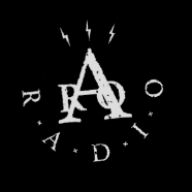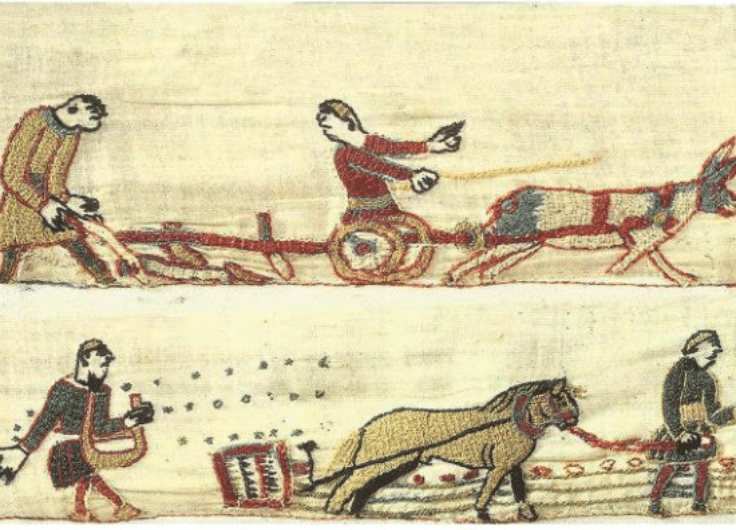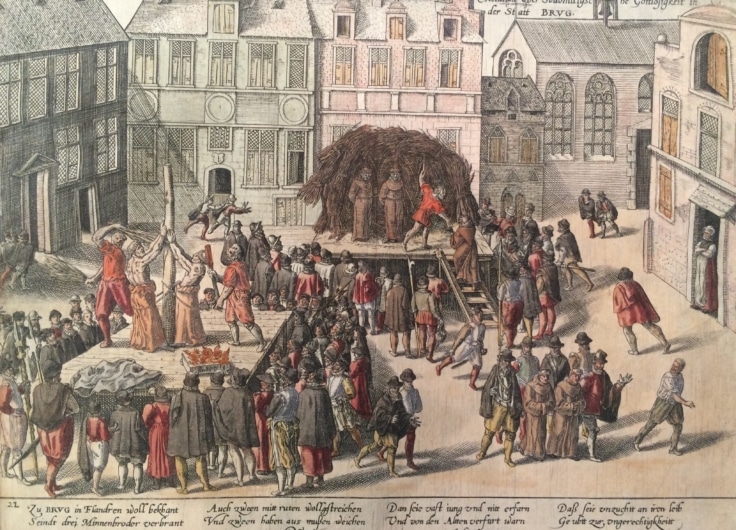These days The Netherlands is one of the most tolerant and liberal places for Jews in the world. Unlike in the 1300s, when Jews often were blamed for the Black Death and subsequently burned at the stake as punishment.
For a long time, the 1300s have been seen as the most awful century in western Europe. Warfare and plague led to an almost complete breakdown of order in the social fabric. Estimates vary and depend on the region, but in less than a decade up to half of the European population died of the Black Death after it first struck in 1348, before returning again later in the century and wiping out another huge chunk. And as bad as all that may be, it would have been even worse if you were a Jew. Because even though you had to live through the same hardships as everyone else, and were exposed to the same pestilence that could destroy your family, there was a very high chance that you were going to be blamed for the plague and subsequently burned to death as punishment.
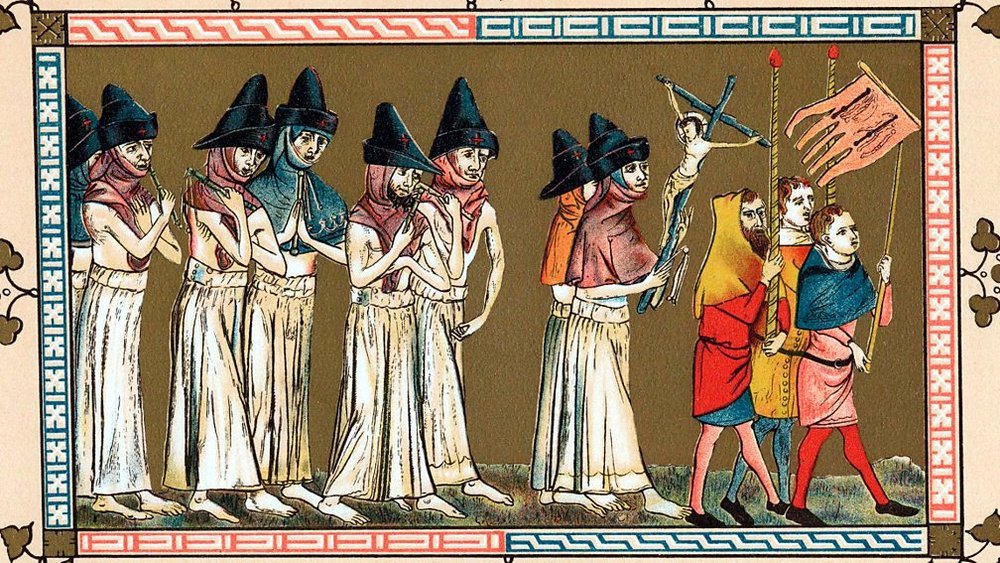 Flagellants in the town of Tournai attempt to stop the plague by whipping themselves. After Paul Fredericq - H.F. Helmolt, History of the World, Volume VII, Dodd Mead 1902. Plate between pages 178 and 179., Public Domain,
Flagellants in the town of Tournai attempt to stop the plague by whipping themselves. After Paul Fredericq - H.F. Helmolt, History of the World, Volume VII, Dodd Mead 1902. Plate between pages 178 and 179., Public Domain,© Wikimedia Commons
Christian Society
Society in the Low Countries in the 14th century was made up of a lot of different people; there were rural folk and town folk, upper class and working class, however there was also a homogeneity to the society that came as a result of the obligation of religion. This was an extremely Christian society wherein the spiritual domination of the Church transcended class and geographical differences. Whether you were a leek farmer in Zeeland, a town alderman in Mechelen, a dijk-builder in Holland, a manorial lord in Limburg, a fiercely independent Frisian, a travelling merchant from Nijmegen, a fuller in Ghent, or the Duke of Guelders, you were almost certainly a Christian.
Although you could be burned for it, there was certainly dissention in ideas of Christianity, and people existed in the 1300s who could rightly have been called reformers. That heresy was a thing defined and punished by the church shows that people did exist who went against the authority of the Church, and that there was never complete compliance with what the church demanded. Discussions and debates amongst each class of society would have existed then as it does now, and there were people who acted on their beliefs. So there were very many different types of people, and people would have had a variety of thoughts about God and everything else. But if you swayed too much towards contradicting the church, or were too public about it, you could and likely would be burned to death as a heretic. Even though you were Christian. And if you weren’t a Christian?
The First Records of Jews in the Low Countries
There are few records of a Jewish presence in the Low Countries prior to the 13th century. One of the earliest pieces of evidence of such is a gravestone found in Tienen, Brabant, from 1255, with the name of a young girl on it: Rebecca. That gravestone, which was only discovered in 1872, doesn’t tell us much, except that by the 1250s there was enough of a Jewish community in Tienen to have a cemetery. The Jewish diaspora is ancient and wide, and there is little doubt that the riverways that connected the ancient Roman Empire with the Low Countries must have carried Jews to this region way before 1250, just as they carried people of many origins. But we just don’t have solid evidence of it.
However, with the growth of industry and urbanisation that happened in the Low Countries from the 1000s on, Jewish people saw opportunity just as commoners from many different regions did. From that point there is little doubt that the fabric of medieval society in the north-western corner of Europe included Jewish culture, as curtailed as it was.
 The gravestone of Rebecca, buried in Tienen around 1255. Royal Museum of Art and History, Brussels
The gravestone of Rebecca, buried in Tienen around 1255. Royal Museum of Art and History, BrusselsIt seems that by the 1250s there was growth in the Jewish communities of Brabant. This is discerned from admittedly scarce sources; the record of a rabbi known as Ravyah, for instance, who lived in Leuven. Expelling Jews is something that would have been experienced in territories and fiefdoms around Europe, as Jews had to pay a tax for just being Jewish, and their expulsion could mean their re-admittance at a higher tax rate. It was a way for rulers to make money, or to expunge their own debt to people who had loaned them money. However, as we have seen, rulers in the Low Countries, like the counts of Flanders or Holland, or the dukes of Brabant, were at this time having to learn how their rule needed to take into account the demands of the modern, urban centres that were upholding a new economic and industrial system. Jewish money-lenders and merchants had their place in this system, so expelling all Jews from an area was fraught with vulnerability, as it would put the functioning of this system at risk. Good business does not like much risk.
It is uncertain how Jews first arrived in the northern Low Countries, but it seems to have begun around the end of the 13th century, and could very well be a direct consequence of their forced emigration from England in 1290 when King Edward I expelled them with a royal decree. Much the same was happening in France and in the Holy Roman Empire. In 1306 the French King, followed the example set by England, also expelled Jews from France. However he soon had to scrap the execution of this plan, due to running into financial difficulty. From the late 1200s and early 1300s, there were Jewish communities not only in Hainault and Brabant, but in Guelders, Overijssel and Limburg. Trade routes between Cologne and Flanders are thought to have been marked by small Jewish communities.
The Miracle of Amsterdam
This truly was a bizarre time when looked at from our modern perspectives. With the exception of Jews, there was an absolutism about the Christian outlook on the world, and the church was the establishment. In enforcing Church doctrine, pressure was exerted on society at many levels. There was a constant presence of the clergy in people’s everyday lives, and a collective demand to attend church, to confess sins, and to take part in Christian rituals.
One such ritual is the Eucharist, in which bread and wine are consumed at a mass to commemorate the last supper of Jesus. During this process, through the workings of God, the bread and wine supposedly become the literal body and blood of Jesus Christ, despite not changing in appearance at all, in a process known as transubstantiation. Even though this was a time when superstitious belief and illogical understandings of things were rife, debate raged as to whether or not this process of transubstantiation was real. Miraculous stories about sacraments doing weird things, like spontaneously bleeding or avoiding calamity, began to circulate throughout all of Europe, including the Low Countries.
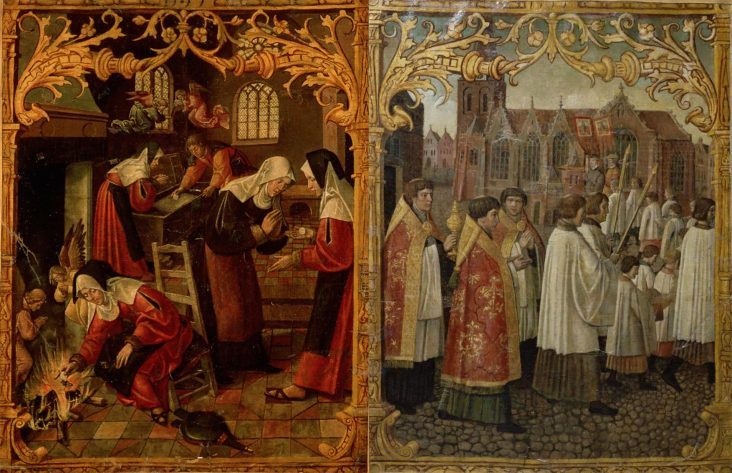 The miraculous fireproof bread. Unknown, Processievaandel, 1555, Amsterdam Museum
The miraculous fireproof bread. Unknown, Processievaandel, 1555, Amsterdam Museum© Amsterdam Museum
One miracle that had very far-reaching consequences happened in Holland on the 16th of March, 1345. The town of Amsterdam had been slowly but steadily growing, but was still basically a fishing village. On that night, an old man lay at his deathbed and, when it looked like his final hours were upon him a priest was called for to hear his confession and to administer the eucharist. So sick was the man, however, that he could not stomach the wafer and proceeded to vomit it up all over himself. The nun tending to him in his hour of need went about cleaning him up and picking up the soggy wafer, which was clearly in need of replacement, threw it in the flames that were flickering in the fireplace behind her. She turned back to the old man, but something caught her eye, and slowly she turned back in the direction of the fire. There, unburnt by the heat of the flames, and levitating freely above them, was the eucharist, the body of Christ. A miracle! The miracle turned the village into a pilgrimage destination and within 100 years Amsterdam’s population had trebled, putting it firmly on the path to prosperity.
The Black Death
In 1347, twelve Genoese trading galleys, bringing goods from the Crimea to Sicily had also brought with them something called Yersinius Pestis, a bacteria that would become known to history as the Black Death. Originating in central Asia, it had been carried by fleas hitch-hiking on and feeding off the backs of infected rodents who had made their way onto ships.
People began to wake up with pustulent sores in their groin area or their armpits, sometimes as big as apples, and also little black spots, probably the markings of the flea bites. Within two to seven days these people had been wrought with fever, and were vomiting blood, before ultimately succumbing. From Sicily, to Venice, up Central and Eastern Europe, to Spain, France, the German cities on the Rhine, and then the Low Countries and to the British Isles; the Black Death ended up killing at least one-third and possibly more than half of the entire Western European population within five years. Soon, given the movement of ships and medieval lack-of-knowledge concerning hygiene and pestilence, the disease followed the rumours. By 1349 it had arrived in the upper Rhine area, and by 1350 in the Low Countries and nobody knew what it was or what caused it. Quite simply, though, the apocalypse was here; the end-of-times.
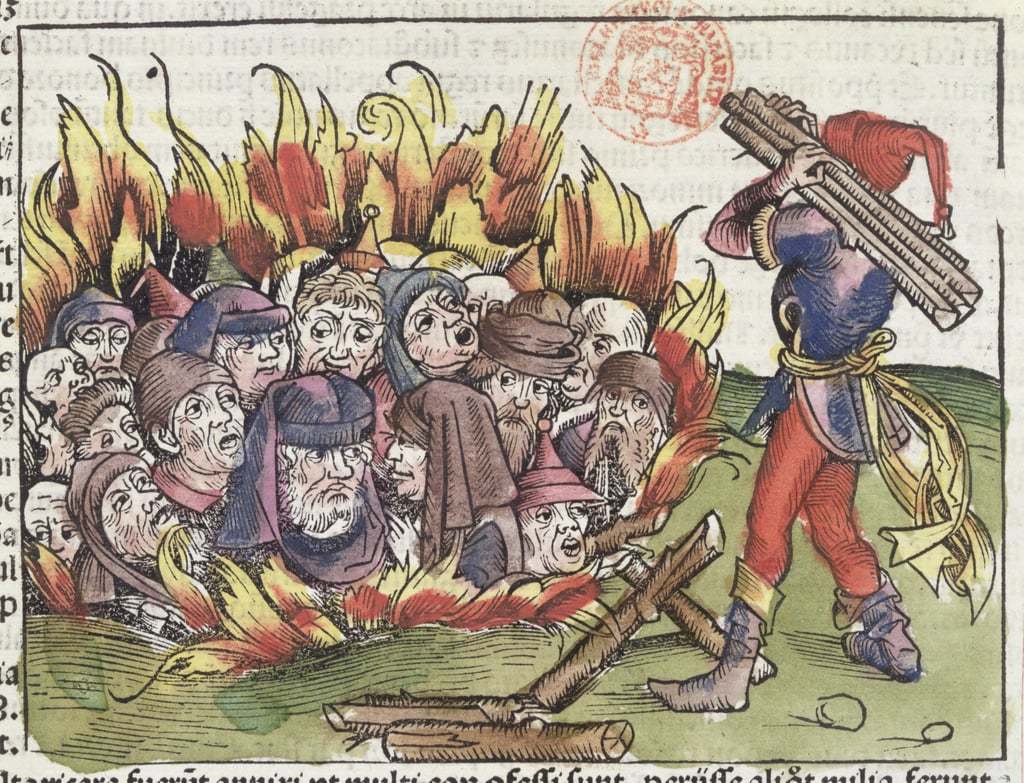 Jews being burned at the stake. Woodcut from the Nuremberg Chronicle by Hartmann Schedel, 1493
Jews being burned at the stake. Woodcut from the Nuremberg Chronicle by Hartmann Schedel, 1493© Meisterdruke.uk
As the plague made its way down the Rhine Valley, and even before the first victims perished in places like Brabant, Jews began to pay the price for it in the southern Low Countries, being blamed for the calamity that was descending upon them all. Pogroms erupted in which Jews were rounded up and burned at the stake, or drowned, or butchered violently. There was an emergence of a social narrative that Jews had caused the Black Death by poisoning wells with concoctions derived from baby-blood and spiders. There were also contemporary people who noticed that, in fact, getting rid of Jews was a way of getting rid of debt, as well as taking possession of their wealth. The eruption of the plague had simply given an external reason for this to occur.
Following their demise during the Black Death, Jews once more came to live in Guelders in the 1370s. Between 1377 and 1397 various Jews were given what is referred to as a Jew pass, allowing them to live in towns in Guelders, but with limitations on things like the amount of interest they could charge and also what avenues were and were not open to them should they have charges brought against them by Christians. By the early 1400s, the tendency of the Dukes of Guelders was a liberalism towards Jewish settlement there, and policies continued in such a vein.
Jews from here on would remain present in the Low Countries – most prominently in Guelders. The reason we decided to dedicate an episode to the especially tragic lot of Jews in this awful period is to highlight the fact there was not a homogeneity of population in these times, which can often become a default perspective on societies in the Middle Ages. Across the Low Countries, as we move into the 15th and 16th centuries, things are going to accelerate towards a ludicrous speed of development; vast changes in population, governance, economics, industry and trade are going to come crashing through in the way that the North Sea was wont to do. Throughout it all, the Jewish presence in the Low Countries is going to have a huge impact on these developments, to the extent that within a few hundred years the Netherlands would arguably become the most tolerant and liberal place for Jews in the world.
Sources
- Black Death, Robert S. Gottfried
- In the Wake of the Plague, Norman F. Cantor
- History of the Jews in the Netherlands, Blom, Fuks-Mansfeld and Schöffer

